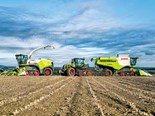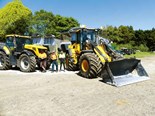Test: The Duncan AS5300 air seeder
Farm Trader heads to Timaru to check out why the the Duncan AS5300 air seeder is so popular both here and over in Australia
Most Farm Trader readers will be very familiar with the Duncan Ag story. A local manufacturer, Duncan Ag employs local staff for local farmers and contractors. The company prides itself on building great gear for New Zealand conditions.
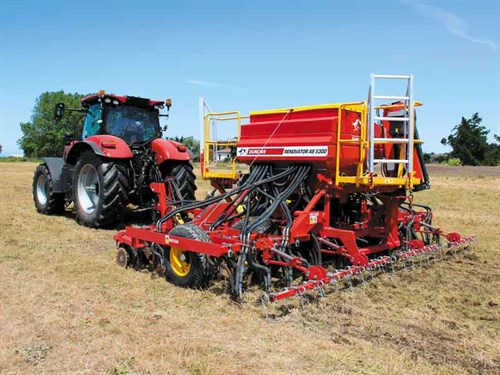
It turns out the Aussies like Duncan Ag gear as well. Both the classic renovator and the larger five- and six-metre air seeders are almost as popular over the ditch as they are here. The latter machine was the reason for a recent trip I made to Duncan Ag’s home base in Timaru.
Machine features
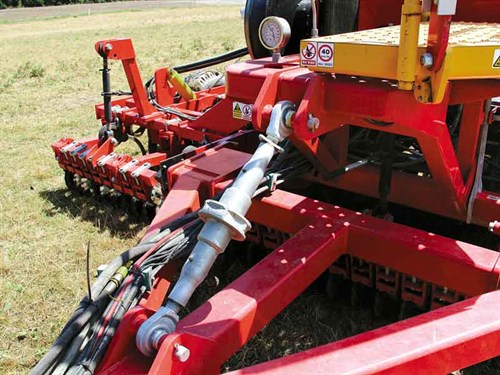
The Duncan AS5300 air seeder, with a 5.3m drilling width, is designed primarily for under-sowing crops or pasture renovation.
It uses front opening discs with a trailing double Baker boot with the seed and fert droppers, followed by covering tine harrows. In all, this set-up leaves a nice tidy finish across the paddock.
The advantage of the tine drill is that it uses a 25mm coil tine to give ground penetration when it’s hard, as well as for contour following and trash clearance. The main reason these are popular – particularly in regions such as Canterbury – is the fact the coil tine with the Baker boot can navigate its way through stony paddocks. This results in the added benefit of significantly lower running costs than a disc drill for these types of conditions.
The AS5300 I tested was the 42 run model, with five-inch spacing. However it’s also available in six- or seven-inch spacing, as well as a 6100 (6.1m) configuration.
These are proving popular both here and in Australia for their simplistic design, coupled with the accuracy of the electronic metering (via radar coupled with an intuitive RDS display monitor). There is also an ISOBUS option available.
Air Seeding
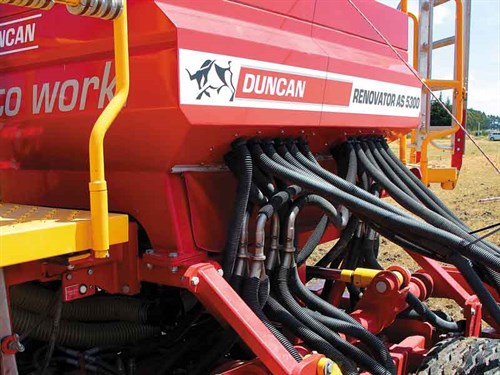
When it comes to folding for transport, the drill sneaks in at 3.1m. Converting to transport configuration is quickly done, with bungies holding bunches of the air-lines close to the drill. This also stops the air-lines flailing around and rubbing holes in each other while you’re drilling. The narrow transport is achieved by having the seeding towers inside the hopper, which also keeps them out of the sunlight and dust.
A clever invention is a ‘Y’ at the base of the air hoses just before they hit the Baker boot. This allows the air to be dispersed from the tank at a higher rate and halved at the ‘Y’; the point where the seed will simply drop to the ground.
It stops the seed blowing into the ground and offers a significant reduction in seed bounce. The hydraulic fan works with two drains back to the tractor and a radiator. A 3/4 drain and a case drain allow oil to quickly return to the tractor, while the radiator allows oil temperature to be cooled and the fan to suck in hot air for the fertiliser.
This sucking in of warm air helps stop the dust build up, with high fert rates getting damp and building up, which can cause blockages.
Another clever feature is a fan damper for fine seeds and low seeding rates, so they don’t get hammered with hurricane-like winds. This is a handy feature, because product like fertiliser is heavier, so as a result more fan speed is required.
Calibration and Metering
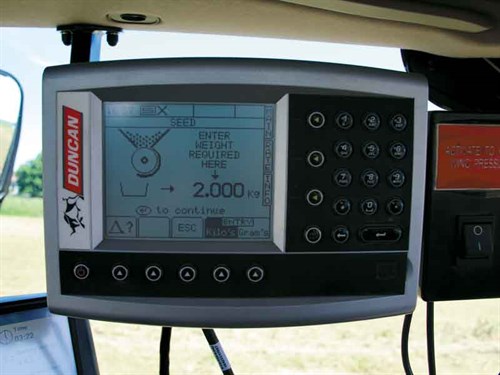
Calibration is really simple on the Duncan AS series. Simply unhook either the front or rear airline, place the plastic container underneath the dropper, push the calibration button on the outside of the machine and the seed will drop out into the container.
Pushing the button again stops it. The RDS controller monitors how long the system has been dropping seed for. You then feed the weight into the controller and the system automatically works out the correct seeding rate.
Ruler type sliders on the metering units offer larger adjustment for contractors between jobs (for example, if grass seed at 25 kg/ha needed to be spread, followed by barley at 180kg/ha at the next job). Essentially, opening the slider allows more product to be let through and slow the metering unit for the heavier rate applications.
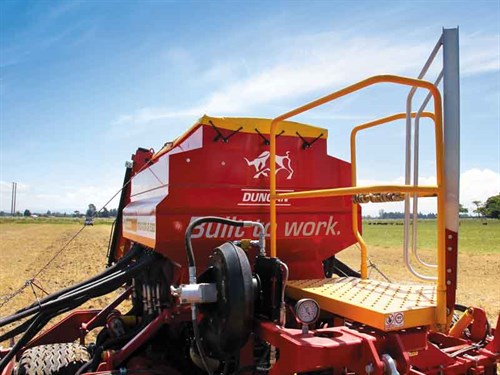
The only real negative here is that the front box is cramped for room and accessibility isn’t great. Even the rear is not as good as some other drills. But on a positive note, the RDS on the cab controller is extremely user-friendly.
The machine has a number of sensors which save the operator from having to jump in and out as the bin starts getting low.
Sensors check the seed and fertiliser levels, while shaft sensors tell you if the seeding metering shaft stops turning. A fan speed sensor and a separate sensor on the transport wheels provide real-time information as to when to start or stop seeding at the headland.

Radar reads the ground speed and works out the forward ground speed for hectare measurements and output rates. This happens independently of the tractor, so it can be easily moved between tractors in a fleet operation, which adds to its usability.
The optional crane at the back of the implement can be specified to lift either half ton or one ton bags.
This really does make the drill a one-man operation, as you’re not waiting for farmers with tractors to turn up and load the seed. The other good thing about this New Zealand-made drill (as opposed to European drills) is the fact it has front and rear loading platforms, with safe lightweight ladders which easily fold up and down.

Seed bags could be thrown up from ground level and then loaded into the hopper, or obviously with a crane straight into the two 1000L hoppers.
Wings and Contour Following
For level seeding, there are four rams across the width of the machine, from the front discs to the rear tine harrows.
The large transport wheels hold the majority of the weight, while the wing wheels are there for depth control as well as contour following. Speaking of contour following, the large dial facing the driving seat modifies wing pressure.
This can be altered via an accumulator. In tough going, this is increased to make the wings rigid or in undulating conditions you may want to float them. Even if you encounter a dip or hollow and have the pressure set high, it reverts to the tractor and allows the wing to hug the ground.
Towing a rubber tyred roller behind these machines works well in conjunction with the tine harrows covering the slots. This is easily done with the rear tow bar and another set of spool valves for folding.
Verdict
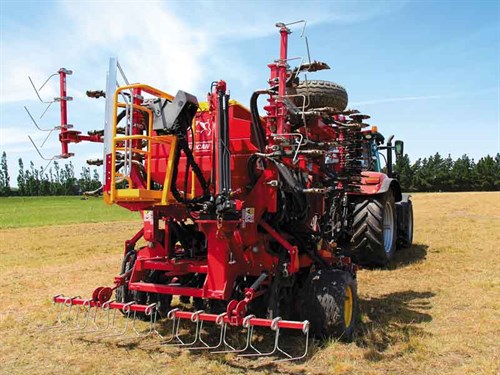
Popular both here in New Zealand and across the ditch, the Duncan AS 5300 is ideal for customers for whom the majority of the work requirement is over-sowing, but where flexibility is still needed.
Direct drilling with the tungsten tip Baker boot is perfect, as it offers penetration in hard ground, but can also work in cultivated ground. It’s great for sorting out crops such as maize with high amounts of stubble, as it offers good trash clearance.
Built tough, with multiple applications and low running costs in mind, yet while still having a working width to cover the ground quickly, the Duncan AS 5300 will tick the box for many.
Pluses
- Strong and simple design
- Well-constructed, using proven components
- Distributor towers are inside hopper to give a clean, compact look
- Plastic container doubles as both calibration and weighing tray, so you don’t double handle the seed
- High and low seeding ratios and small and large seed cogs help cater for all varieties
- Rear crane helps load half-ton or full-ton bags for larger clients
- Large non-slip bin loading area with safety rails
- Grating inside the hoppers stops fert and seed clumps blocking the pipes and doubles as a scale storage area
Minuses
- Calibration numbers on the scale are very fine
- Accessibility to the front bin for calibration is difficult
Keep up to date in the industry by signing up to Farm Trader's free newsletter or liking us on Facebook




.jpeg)



.jpg)


